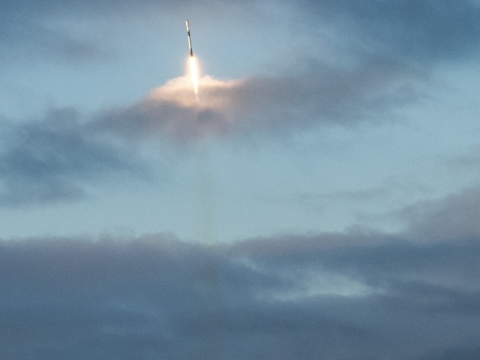DISA and JFHQ-DODIN Leader Readies To Pass the Torch
After 40 years of military service, Lt. Gen. Robert Skinner is retiring from being the director of the Defense Information Systems Agency (DISA) and the commander of Joint Force Headquarters-Department of Defense Information Network (JFHQ-DODIN), two of the U.S. Department of Defense's (DoD's) most critical network, communications and information technology support agencies.
“It's been an honor of a lifetime,” Skinner said of his dual-hatted role that he has been in for the last three and a half years. “If there was one position that our senior leaders positioned me for, I think it was this one.”
Following Vice Adm. Nancy Norton’s leadership, Skinner took the helm of DISA and JFHQ-DODIN in February 2021 during the COVID-19 pandemic, where he stepped into the challenges of maintaining 24/7 operations with a partially remote workforce. Despite the disruptions, he guided both organizations to new heights in supporting warfighters and defending DoD networks.
“There is no mission in the Department of Defense that these two organizations aren't enabling, driving and improving,” Skinner noted. “That is pretty powerful.”
His degrees in computer science served him well as he guided the organizations’ adoption of advanced communications, cybersecurity measures and emerging digital solutions. Skinner graduated summa cum laude with a Bachelor of Science in computer science from Park College in 1989, followed by a Master of Science in computer science with honors from Oklahoma City University.
Skinner’s experience in the early 1990s programming and as chief for the Airborne Warning and Control System at Tinker Air Force Base (AFB), Oklahoma, provided a foundational understanding of mission software. His role as chief of the Database Engineering Section for three years at U.S. Strategic Command at Offutt AFB, Nebraska, provided an early look into joint and combatant command (COCOM) data mission needs.
In the last decade before stepping into his current roles, the leader spent several years at DISA, JFHQ-DODIN and at U.S. Cyber Command, all at Fort Meade, first as deputy commander of Air Forces Cyber, then as DISA chief of staff and JFHQ-DODIN deputy commander.
In July 2017, Skinner became deputy commander of Air Force Space Command at Peterson AFB before it became Space Operations Command in 2020, after the Space Force stood up in December 2019. The general commanded 24th Air Force, then known as Air Forces Cyber, at Joint Base San Antonio-Lackland, Texas, and helped to construct the numbered air force’s evolution into 16th Air Force that united the cyber operations with the service’s other information warfare missions.
Before taking on his current roles, Skinner was the director of Command, Control, Communications and Cyber (C4) for the U.S. Indo-Pacific Command at Camp H.M. Smith, Hawaii, beginning in October 2019. This experience helped provide an understanding of what would be needed in C4, networks and transport to support the command’s area of responsibility against near-peer threats from the People’s Republic of China. Over the last several years, DISA has invested heavily in information technology and communications capabilities for the U.S. territory of Guam, especially, and across the entire region.
For example, under Skinner’s guidance, the agency’s Airborne Intelligence, Surveillance and Reconnaissance (ISR) Program supported additional video and sensor dissemination capabilities, tactical relays, ISR ground stations and ISR network operations used by COCOM commanders, providing a strategic interface to the backbone the Defense Information System Network. The agency also installed and operationalized additional multiprotocol label switching nodes at Naval Base Guam.
The focus in supporting the various COCOMs and consistently delivering mission-needed capabilities is one of Skinner’s proudest accomplishments.
“We have really been focusing on support to combat commands, focused on transparency, focused on delivering capabilities,” he said. “We have significantly improved the efficiency and effectiveness of the department. And I would offer that the department is more lethal because of what these two organizations have done.”
Another success Skinner cited is the successful implementation of the Joint Cloud Warfare Capability (JWCC), in partnership with DoD leadership, including the DoD chief information officer. In less than two years, DISA’s Host and Compute Center—now known as the J9 HAC—has executed over $1 billion in task orders under the JWCC, providing DoD components with streamlined access to cutting-edge commercial cloud services from four major cloud service providers across various classification levels: unclassified, secret and top-secret classification levels, including Impact Level 6.
“We’re providing commercial parity everywhere from the strategic enterprise all the way down to the tactical level that is supporting the needs of our warfighters and our customers,” Skinner explained.
Most JWCC task orders are now executed very quickly—in less than a month—which is a dramatic improvement over typical government contracting timelines, he said.
Additionally, the JWCC program complements DISA’s “hybrid cloud broker” approach, combining the commercial cloud offerings with on-premise J9 HAC-operated cloud environments to meet diverse mission needs, the general noted.
DISA’s focus on developing and adopting emerging technologies has been most striking, with its pursuit of cutting-edge pilot programs and other efforts across zero trust, artificial intelligence, defensive cyberspace operations, and identity, credentialing and access management. The agency’s proactive approach, especially through its chief technology officer, Steve Wallace, has supported continuous evaluation of innovative technologies that could help address operational challenges.
“Our CTO [chief technology officer] is actively engaged with industry every single day,” Skinner noted.
With the JFHQ-DODIN mission requiring 24/7 adroit operations to protect and defend DODIN, the global command and control network on which the COCOMs rely, Skinner observed how far the organization has come since its early inception in 2015.
“There is no one in the department that I know of, or I’ve talked to, that doesn’t understand why we have JFHQ-DODIN and the effectiveness of that organization,” he stated.

In addition, JFHQ-DODIN and its operational framework for cyber defense have become a model that allies, partners and even commercial companies try to emulate.
“To me, that is the biggest thing,” Skinner noted. “[It is] the changing of [their understanding of] 'Why are you here?' to 'We know why you're here, and you're actually providing prioritization and capabilities for us to be better postured against our own strategic threats,’” the leader explained.
Another key focus has been accelerating decision-making and unified action across the DoD to keep pace with increasingly agile adversaries. And here, the ability of the two organizations to leverage emerging technologies is enabling faster responses to cyber threats, vulnerabilities, communications and network needs.
“How do we get unified action at pace and scale as the adversary gets more agile and more maneuverable?” he stated. “How do we take our structures and continue to refine them and bring technology to bear so that we can make decisions faster that then enables unified action quicker?”
Reflecting on challenges faced during his tenure, Skinner pointed to the impacts of the pandemic, particularly in the early days of alternating on-site and remote work weeks. “That was a huge challenge of making sure we took care of the force first and foremost, and then, how do you accomplish the mission with a force that is there part of the time,” he recalled.
As Skinner prepares to hand over the roles to his successor, Maj. Gen. Paul Stanton, USA, during the change of command ceremony at Fort Meade on Friday, Skinner emphasized the strong organizational foundations established during his tenure. This includes aligning DISA’s structure more closely with the COCOMs and implementing process improvements for technology prototyping and sustainment.
For JFHQ-DODIN, Skinner pointed to the development of a campaign plan with clear priorities around partnerships, battlespace awareness and protection. “We’ve kind of built that foundation that says, ‘Here are the priorities that we’re going to be going over the next couple years,” he explained.
One ongoing initiative Skinner said he hopes will continue is the migration of DoD components to a unified network environment. The goal is to eventually bring the COCOMs and even mission partners onto a common, so-called DoDNet to enhance interoperability.
When asked about advice for industry partners, the leader stressed three key points: for companies to truly understand DISA’s and JFHQ-DODIN’s missions and challenges; to ensure solutions are actually scalable to the DoD’s very complex, huge, dynamic environment; and to focus on simplicity of design when delivering capabilities.
“We are the third largest network in the world, if you talk about internet protocol addresses,” he noted. “So, how do you make sure that your capabilities can scale? And then make it simple.”
For young people considering careers in defense, information technology and cybersecurity, Skinner encouraged exploring the rewarding internship opportunities with both DISA and JFHQ-DODIN.
“There are things that you can do within the agency and the command that you can't do in the outside world,” he said, emphasizing the unique missions and experiences available in government service.





Comments